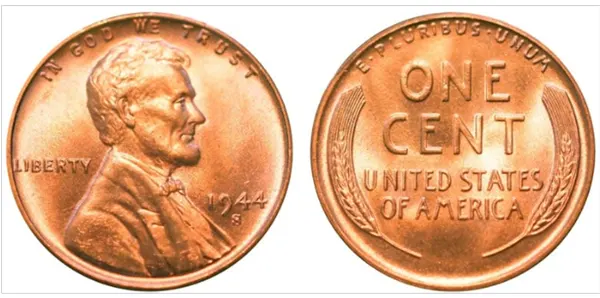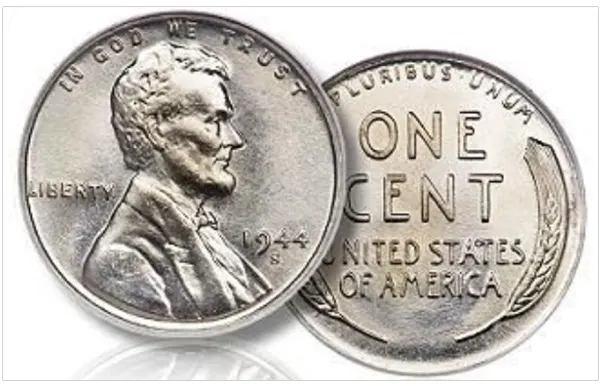The authenticity of the steel wheat penny can be checked through the following two steps.
- Check the magnetism of the coin. If it attracts the magnet, it is real.
- Evaluate the weight of the coin. If it weighs around 2.7 grams, it is real.
Considering the rarity, uniqueness, and history of old items, collectors value them for a significant amount of money. One such item that has become popular nowadays is Abraham Lincoln’s 1944 wheat penny coin.
The 1944 wheat penny value ranges from hundreds to thousands of US dollars. These Abraham Lincoln imprinted copper coins are extremely scarce and can be seen only at auctions.
Because of the high worth of these coins, it has become extremely necessary for us to educate readers about their history, market valuation, factors influencing their value, and identification of real pennies.

1944 Wheat Pennies are US-minted coins with the impression of Abraham Lincoln.
Due to their scarcity, the 1944 steel coins are always in demand by auctioneers. Nowadays, these coins can be sold from anywhere between hundreds to thousands of US dollars in auctions.
Furthermore, these coins are called Wheat Pennies because of the dry wheatgrass impression on the back. These coins were mainly minted in the mints of Philadelphia, Denver, and San Francisco, with a 19:1 composition of copper and zinc, respectively.
The 1944 wheat coins were introduced in the United States when people started disliking the 1943 coins due to their tendency to easily lose zinc coating and their similarity with the dime, a ten-cent coin. 1943 was the year when these coins were first and last minted.

Later in 1943, zinc-coated copper and tin coins were replaced with steel coins due to the need for copper weapon artillery in war. In 1944, coins were again made with copper and zinc, but now the zinc is not coated but mixed with the copper to prevent rusting. Tin was removed from the composition due to the scarcity of tin in the environment.
When the question was raised about the sudden increase in the supply of copper, the greatest numismatic scholar, Roger W. Burdette, revealed that the copper from bullet shells is recycled to manufacture wheat cent coins.
Depending on the condition, the 1944 wheat penny value ranges from 15 cents to up to $20,000, depending on various factors.
People actually think that only copper wheat pennies were minted in 1944, but there is more to this fact. After a few years passed, it was found that there were 3 types of coins with 1944’s impression, namely steel wheat coins, silver coins, and D/S wheat coins.

Due to the double die issue in mints, some coins produced in Denver were mistakenly printed with S markings. Later, the S marking was replaced with the D, leaving some markings on coins. You can easily see the S impression over D in the picture above. Such markings make 1944 wheat pennies extremely rare and unique.
These erroneous 1944 wheat penny values range between $50,000 and $60,000.

After the steel was replaced with a composition of copper and zinc, there was some leftover steel in the mints that was ultimately used to produce coins. Eventually, these coins were marked with the 1944 impression. Such incidents are called transitional errors and were first witnessed in 1943 when the copper-alloy leftovers from 1942 were used.
According to the NGC Price Guide, a steel wheat penny is worth between $35,000 and $43,000. However, on the open market, a 1944 steel penny in pristine condition sells for as much as $175,000.

The 1944 silver coins were error coins that were made out of steel instead of copper. But because they were lustrous, they were called silver coins. At present, it is found that only 50 of such coins are currently in circulation, making them one of the most rare wheat pennies. Among these 50 coins, 7 are produced in the Denver mint, 2 in the San Francisco mint, and the rest are produced in the Philadelphia mint.
The auction price for a silver coin from the Philadelphia Mint is around $180,000, and it is just the auction price; the actual price goes even higher. One silver coin of San Francisco mint is even sold for $408,000.
The value of 1944 Wheat Pennies depends on the following factors:
The 1944 wheat pennies were produced in only three mints each in Philadelphia, Denver, and San Francisco. Each penny bears the mark of the respective mint except for Philadelphia, i.e., D for Denver minted and S for San Francisco. Out of these three mints, coins minted in San Francisco are the rarest due to the lower production of coins as compared to other mints.
It means S marked 1944 wheat penny values are higher than the other two, and if you are holding one of them, you can exchange it for a significant amount of money.
The physical condition of 1944 wheat pennies is the most crucial factor defining their values. The more pristine the penny is, the higher its value will be. For example, the value of an uncirculated penny will be higher than that of a circulated penny.
Remember that uncirculated pennies are valued the most, followed by moderately circulated and frequently circulated ones.
The theory of demand and supply defines that demand and supply are connected. As the supply of any particular thing decreases, the demand for it increases among the people. This phenomenon is also applicable to the 1944 wheat penny value. The rarest to find are the most demanded, whereas the common pennies hold comparatively less value.
Some of the rarest 1944 Wheat Pennies are the double-died or wrongly mint-marked pennies.
Pennies minted during June, July, and August have higher values as these were the months of the Normandy battle. Also, battles often lead to the destruction of coins, making surviving pieces rare and valuable. These coins are valuable to collectors because they have a history, which makes them unique.
Several physical conditions determine the worth of a coin. One of these conditions is color designation, as categorized below.
In the table, the MS (Mint State) shows that the coins are uncirculated, and the numbers represent the Mint State grades. Furthermore, the + indicates that the coin is between two grades, which means an MS64+ will be more expensive than an MS64 and cheaper than an MS65.
| Description | Designation | MS63 | MS64 | MS65 | MS66 | MS67 | MS68 |
| 1944 | RD | $8 | $14 | $16 | $30 | $200 | $13,000 |
| + | $9 | $15 | $20 | $45 | $750 | – | |
| 1944 SteelEst. 25-30 known | MS | $87,500 | – | – | – | – | – |
| + | $1,85,000 | – | – | – | – | – | |
| 1944-D | RD | $10 | $16 | $22 | $35 | $315 | $9,500 |
| + | $12 | $18 | $26 | $65 | $575 | ||
| 1944-D Steel7 known | MS | $90,000 | – | – | – | – | – |
| + | – | – | – | – | – | – | |
| 1944-D/S | BN | $450 | $500 | $650 | $850 | – | – |
| + | $460 | $565 | $675 | – | – | – | |
| 1944-D/S | RB | $450 | $625 | $1,100 | – | – | – |
| + | $500 | $700 | – | – | – | – | |
| 1944-D/S | RD | $600 | $700 | $1,750 | $2,650 | $35,000 | – |
| + | $625 | $1,100 | $2,000 | $14,000 | $57,500 | – | |
| 1944-S | RD | $10 | $14 | $18 | $26 | $125 | – |
| + | $11 | $15 | $20 | $40 | $1,000 | – | |
| 1944-S Steel2 known | – | – | – | $475,000 | – | – | |
| – | – | – | – | – | – |
To confirm the authenticity of your 1944 wheat penny, you have to check for a few important characteristics. Make sure your coin has the below-mentioned physical features, confirming the authenticity of a real 1944 wheat penny.
If these features aren’t present on your coin, it is most likely to be a fake coin.
At present, collectors are ready to pay thousands of dollars for 1944 wheat pennies, which would have been worth a cent in 1944. They collect these coins because they are extremely rare and hold historical significance in the minds of US citizens.
Before selling these coins, you have to check their worth. Go through the aforementioned value chart to check your 1944 wheat penny value to make sure you aren’t overpriced.